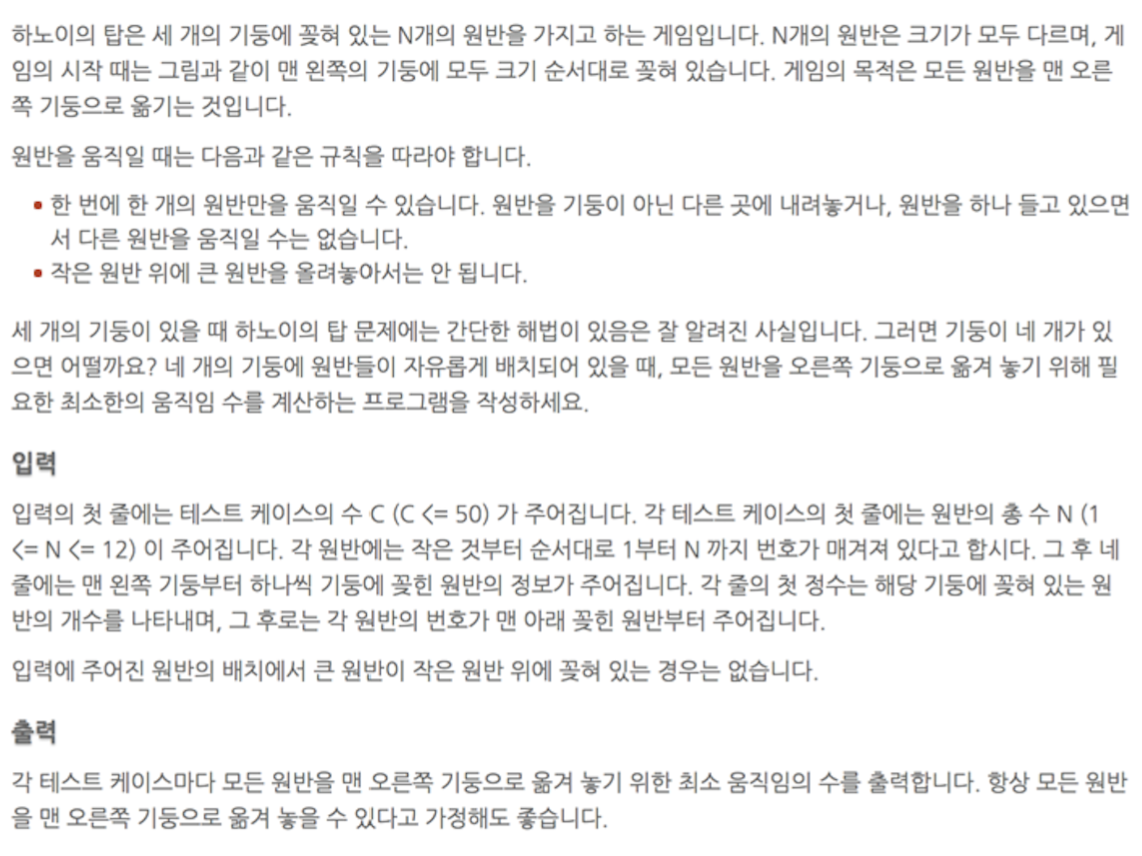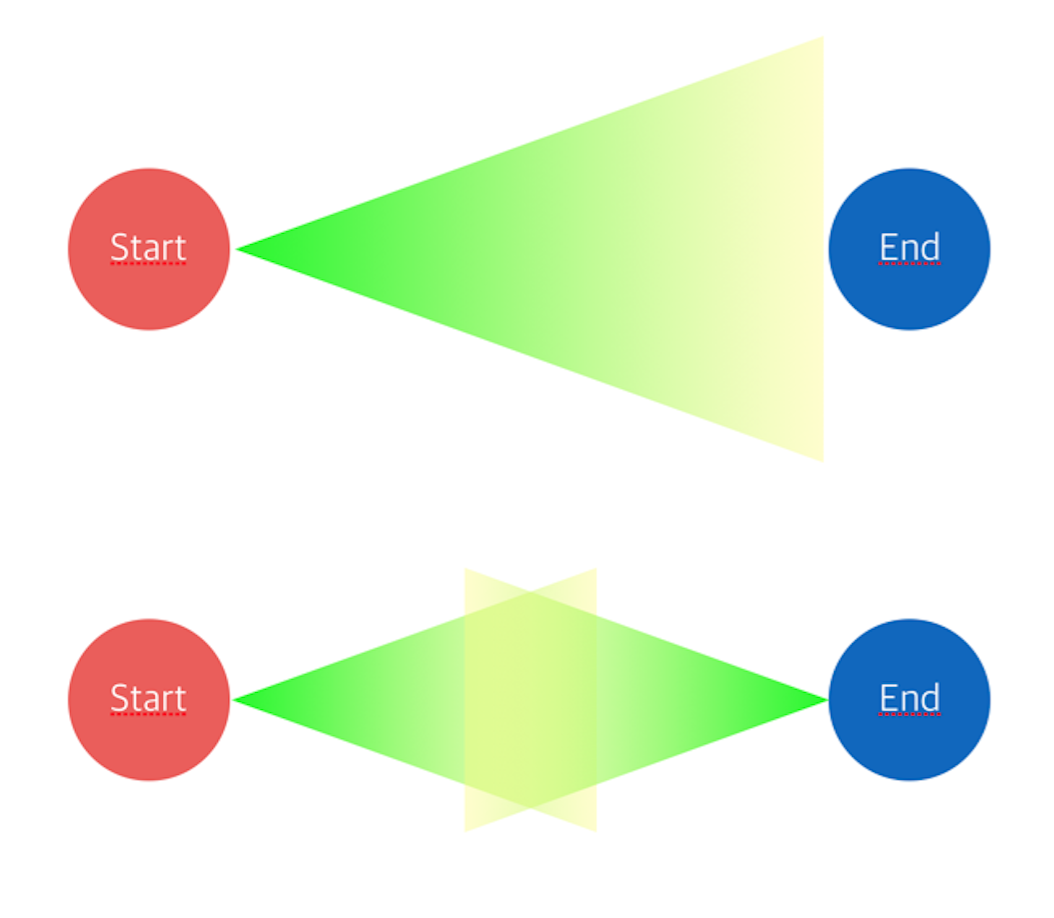- 1. Problem
- 2. My Approach
- 3. Implementation
- 4. Textbook Approach
- 5. Implementation
- 6. Analysis
- 7. Feedback
1. Problem

2. My Approach
- 4개의 stack을 생성해 각각에 원반을 위치시킨다.
- bfs 를 통해 다음의 과정을 반복한다.
각각의 원반의 위치를 검사하고, 목표값과 다를 시에 가장 위에 위치한 임의의 원반을 임의의 기둥으로 옮긴다. 원반을 한번 옮겼을 때 발생하는 경우의 수를 모두 계산한 뒤, 그 중에 없으면 이 경우들에서 한 번 더 옮겨 반복한다.
3. Implementation
- 두 개의 큐를 선언한다.
- toCheck : 목표값과 같은 지 검사해야할 값들 저장.
- toMove : 검사결과 목표값이 아니어서 위치를 옮겨야 될 값들 저장.
- 이 전에 푼 SortGame과 같은 실수를 저질렀다. 수행시간뿐만 아니라 메모리도 기하급수적으로 늘어난다.
//
// main.cpp
// HANOI4
//
// Created by Heejun Lee on 7/25/17.
// Copyright © 2017 Heejun Lee. All rights reserved.
//
#include <iostream>
#include <stack>
#include <queue>
using namespace std;
struct Hanoi {
stack<int> sticks[4];
int count;
};
int T,N;
queue<Hanoi> toCheck;
queue<Hanoi> toMove;
int move(Hanoi hanoi){
toCheck.push(hanoi);
while(1){
while(!toCheck.empty()){
cout << "Count:" << toCheck.front().count << endl;
cout << toCheck.front().sticks[0].size() << " " <<toCheck.front().sticks[1].size() << " "<<toCheck.front().sticks[2].size() << " "<< toCheck.front().sticks[3].size() << endl;
if(toCheck.front().sticks[3].size() == N) return toCheck.front().count;
toMove.push(toCheck.front()); toCheck.pop();
}
while(!toMove.empty()){
for(int from=0;from<4;from++)
for(int to=0;to<4;to++)
if(from!=to)
if(!toMove.front().sticks[from].empty())
if(toMove.front().sticks[to].empty() || toMove.front().sticks[from].top() < toMove.front().sticks[to].top()){
toMove.front().sticks[to].push(toMove.front().sticks[from].top()); toMove.front().sticks[from].pop();
toMove.front().count++;
toCheck.push(toMove.front());
toMove.front().count--;
toMove.front().sticks[from].push(toMove.front().sticks[to].top()); toMove.front().sticks[to].pop();
}
toMove.pop();
}
}
}
int main() {
cin >> T;
while(T--){
Hanoi hanoi;
hanoi.count=0;
cin >> N;
for(int i=0;i<4;i++){
int nums;
cin >> nums;
while(nums--){
int num;
cin >> num;
hanoi.sticks[i].push(num);
}
}
cout << move(hanoi) << endl;
while(!toMove.empty()) toMove.pop();
while(!toCheck.empty()) toCheck.pop();
}
return 0;
}
- 시간 초과 이전에 메모리 초과로 Runtime Error가 발생한다.
- 주어진 상황을 의미하는 4개의 stack은 bfs로 다루기에 사이즈가 너무 크다.
이전의 SortGame 에선 이를 극복하기 위해
map을 사용했지만 본 문제는 기둥의 관점이 아니라 원반의 관점에서 봤을 때, 각각 1~4의 값을 가지므로 이는 2bit만으로도 표현이 가능하다. 따라서 map 대신에 Bitmask를 적용할 수 있다.
4. Textbook Approach
두가지의 풀이가 주어진다.
- 본인의 코드와 비슷하지만 단일
Queue와 Bitmask를 사용하여 메모리가 커지는 것은 막았지만 시간 초과는 여전히 일어난다. - 시작 상태와 마지막 상태를 알고 있으므로 양방향에서 접근하도록 구현하였다.
5. Implementation
1. 단일 큐와 Bitmap 사용 알고리즘
- 별도로
get( )과set( )함수를 만들어 좀 더 편하게 Bitmask를 이용할 수 있게 하였다. - 각각의 상황이 되기까지의 뒤집은 횟수를 저장하는
cache역할을 하는 배열도 Bitmask로 구현하였다.처음 방문하지 않은 상태의 뒤집은 횟수는 -1로 초기화한다.
#include <iostream>
#include <queue>
#include <cstring>
using namespace std;
int T, N;
const int MAX_PAN = 12;
int c[1<<(MAX_PAN*2)];
// index : 원반 번호
// value : 막대기 번호
int get(int state, int index){
return (state >> (index*2)) & 3;
}
int set(int state, int index, int value){
return (state & ~(3<<(index*2))) | (value << (index*2));
}
int bfs(int discs, int begin, int end){
if(begin == end) return 0;
queue<int> q;
memset(c, -1, sizeof(c));
q.push(begin);
c[begin]=0;
while(!q.empty()){
int here = q.front();
q.pop();
int top[4] = {-1,-1,-1,-1};
for(int i=discs-1;i>=0;--i)
top[get(here,i)]=i;
// i번 기둥의 맨 윗 값을 j번 기둥으로 옮긴다
for(int i=0;i<4;++i)
if(top[i] != -1)
for(int j=0;j<4;j++)
if(i!=j && (top[j] == -1 || top[j]>top[i])){
int there = set(here,top[i],j);
if(c[there] != -1) continue;
c[there] = c[here] + 1;
if(there == end) return c[there];
q.push(there);
}
}
return -1;
}
int main() {
cin >> T;
while(T--){
cin >> N;
int num,n;
int first=0;
int end = pow(2, 2*N)-1;
for(int i=0;i<4;i++){
cin >> num;
for(int j=0;j<num;j++){
cin >> n;
first = set(first,n-1,i);
}
}
cout << bfs(N, first, end) << endl;
}
return 0;
}
2. 양방향 알고리즘
- 기존의 bfs 알고리즘과 큰 차이는 없다.
- 다만 정방향과 역방향을 구분하기 위해 각각 뒤집히는 갯수가 증가하는 개념을 양의 방향과 음의 방향으로 나누었다.
incr( ): 방향에 맞게 1씩 증가시키는 함수sgn( ): 뒤집힌 갯수의 부호를 반환해서 어느 방향에서 접근한 건지 구분- 때문에 뒤집힌 갯수를 저장해 놓는 캐시는 -1이 아닌 0으로 초기화하고 양쪽의 시작점(begin과 end)에서의 값은 각각 1과 -1부터 시작한 뒤 마지막에 반환할 때 1을 빼준다.
- 가운데서 만난 경우
here로부터 접근한there가 방문한 기록이 있고(c[there]!= 0),c[there]의 부호와c[here]의 부호가 다른 경우 이는 양방향에서 접근하던 두 진행이 만난 것을 의미한다. 따라서 이 두 경우를 더하는데, 처음 초기값을 0이 아닌 1 또는 -1로 했기 때문에c[there]-1 과c[here]의 합을 반환하는 것에 주의하자.
int sgn(int x){
if(!x) return 0;
return (x>0)?1:-1;
}
int incr(int x){
if(x<0) return x-1;
return x+1;
}
int bidir(int discs, int begin, int end){
if(begin == end) return 0;
queue<int> q;
// 초기화를 0으로 하는데 주의
memset(c, 0, sizeof(c));
q.push(begin); c[begin]=1;
q.push(end); c[end]=-1;
while(!q.empty()){
int here = q.front();
q.pop();
int top[4] = {-1,-1,-1,-1};
for(int i=discs-1;i>=0;--i)
top[get(here,i)]=i;
// i번 기둥의 맨 윗 값을 j번 기둥으로 옮긴다
for(int i=0;i<4;++i)
if(top[i] != -1)
for(int j=0;j<4;j++)
if(i!=j && (top[j] == -1 || top[j]>top[i])){
int there = set(here,top[i],j);
// 아직 방문하지 않은 정점인 경우
if(c[there] == 0){
c[there] = incr(c[here]);
q.push(there);
}
// 가운데에서 만난 경우
else if(sgn(c[there]) != sgn(c[here]))
return abs(c[there]) + abs(c[here]) - 1;
}
}
return -1;
}
6. Analysis
- 양방향 탐색의 코드를 보면 너비 우선 탐색과 크게 다르지 않은 것을 알 수 있다. 하지만 실제 방문하는 정점의 수는 크게 줄어들고, 실제 수행 시간도 열 배 가까이 감소하는 것을 확인할 수 있다.

7. Feedback
- 메모리를 효율적으로 다루기 위해 Bitmap에 익숙해지자.
- bfs의 또 다른 최적화 방법으로 양방향 접근이 가능하다는 것을 명심하자.